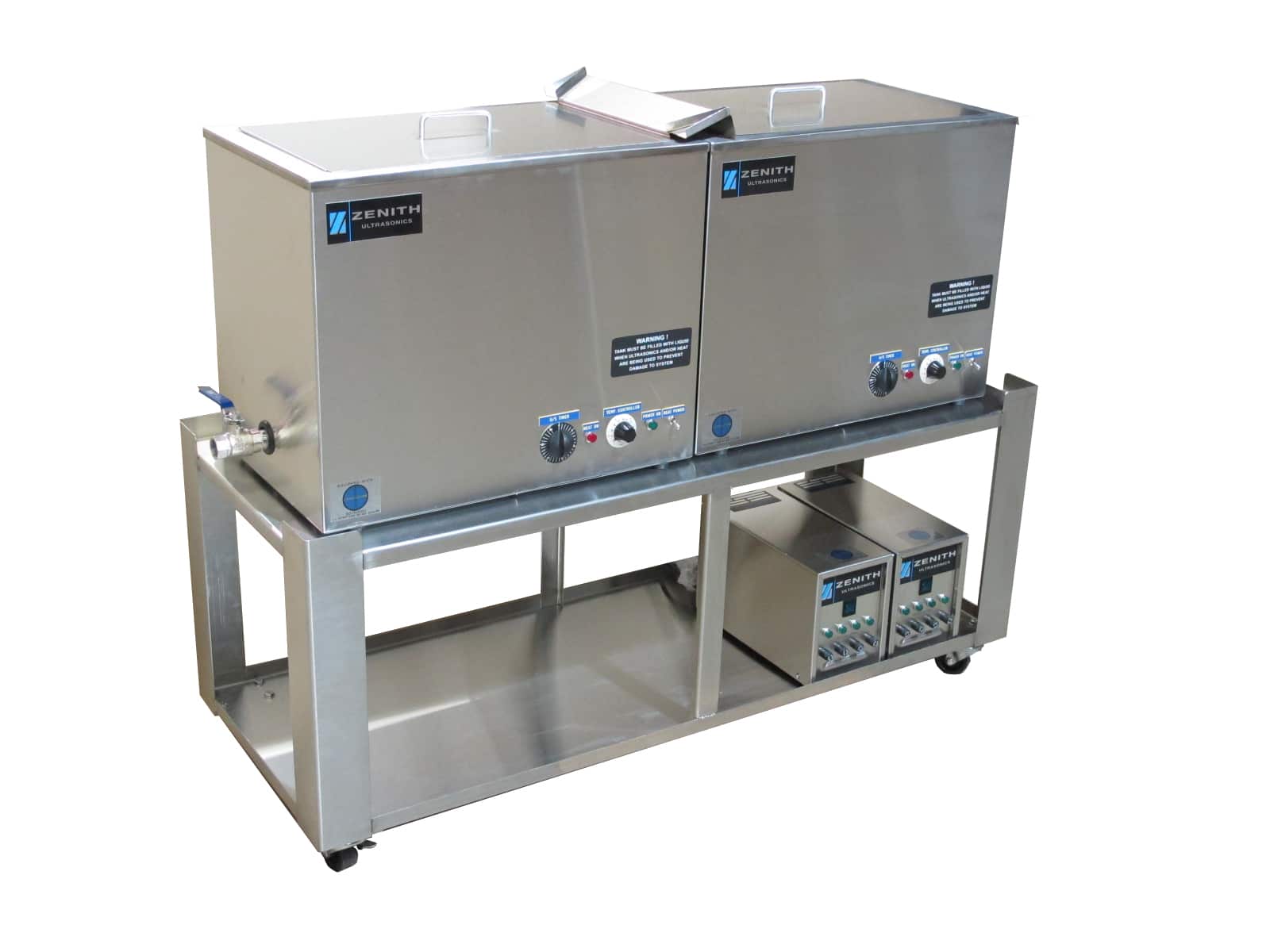Benchtop Ultrasonic Cleaners with Cleaning & Rinsing Tanks
The Zenith benchtop ultrasonic cleaners can include both cleaning and rinsing tanks, but without a drying tank. These types of systems can be attractive when you already have a drying method, or dont need one and load capacities are 35 pounds or less..
Some applications or customers do not require a drying operation, and customers want a lower-cost ultrasonic cleaning system option. Our benchtop ultrasonic cleaners with cleaning & rinsing tanks are the perfect fit for these applications. If parts require drying, they can be dried using existing compressed air guns or heated drying ovens
A number of different formats can be created based on your specific needs. You can have dual ultrasonic cleaning tanks when the parts are very dirty, and one or 2 rinsing tanks.

- MEC2-400-1: 14″ x 10″ x 12″ tall tank size
- MEC2-800-2: 20″ x 12″ x 14″ tall tank size
- MEC2-1200: 24″ x 18″ x 15″ tall tank size
- All 316L stainless steel construction.
- 3/4″ drain valves.
- Heating system with dial temperature controllers on each tank.
- Choice of ultrasonic frequencies: 25kHz, 40kHz, 80kHz, or CROSSFIRE Multiple Frequency Ultrasonics.
- 0-30 minute mechanical timer.
- Separate power connection for each tank.
- Fill and overflow ports on rinse tanks.
- Digital Temperature Controllers which provide readout of actual bath temperature.
- Digital Cycle Timers which display setpoint and actual values with range up to 99 hours.
- Stainless steel support cart with casters.
- Single-point electrical connection to power both tanks.
- NEW: EAS Economy Automation Systems designed specifically for this series of systems.
Download our MEC brochure HERE.
What is included in the benchtop ultrasonic cleaners with clean & rinse?
Single or multiple benchtop ultrasonic cleaners include an ultrasonic cleaning tank to remove the contamination. Next, one or more rinsing tanks are included to remove the detergent which was used in the ultrasonic cleaning tank.
Why might I need a rinsing tank?
In most cases. benchtop ultrasonic cleaners will use detergents or soaps to remove the dirt from the parts. Detergents greatly enhance the operation of a benchtop ultrasonic cleaner, or large scale cleaning machine. Rinse tanks are used to remove the detergent from the parts, since detergents will leave spots on the parts. This is rarely acceptable.
How many rinse tanks do I need?
That depends on the number of parts you intend to clean during the day, and the type of result you are trying to obtain.
- If you are cleaning a small number of parts, and water spotting is acceptable, then only a single rinse tank is needed.
- If you want pristine parts with no water spots on them, or are cleaning a greater number of parts during the day, then 2 cascading rinse tanks are recommended.
- Zenith can assist you in determining the number of rinse tanks to include with your benchtop ultrasonic cleaner.
What is a Cascading Rinse Tank?
A cascading rinse tank is actually 2 rinse tanks which share the same water supply. Consider that each time a basket is moved from the benchtop ultrasonic cleaner tank to the rinse tank/s:
detergents are added to the rinse tank. These detergents will cause spotting on the parts to be produced, even if purified water is used.
To prevent these spots, cascading rinse tanks are used.
When the detergent levels in the rinse tanks build to unacceptable levels, fresh water is added to the FINAL rinse tank, which then overflows into the FIRST rinse tank. The first rinse tank then overflows to drain.
This type of arrangement does the following:
- Ensures that the final rinse tank (the most important one) has the best water quality and lowest detergent levels.
- Keeps pushing the detergents away from the final rinse tank.
Since both rinse tanks share the same single water supply, water consumption is reduced. - Important Note: The greater the number of rinse tanks, the less water that will be needed to obtain the desired results.
Do I need an ultrasonic rinse?
It depends on the type of parts being cleaned. An ultrasonic rinse is helpful if parts being cleaned are highly detailed, and zero-residue results are needed. Details might include small-diameter blind holes, internal channels and passageways, metal folds, screw threads in many different directions, and others.

